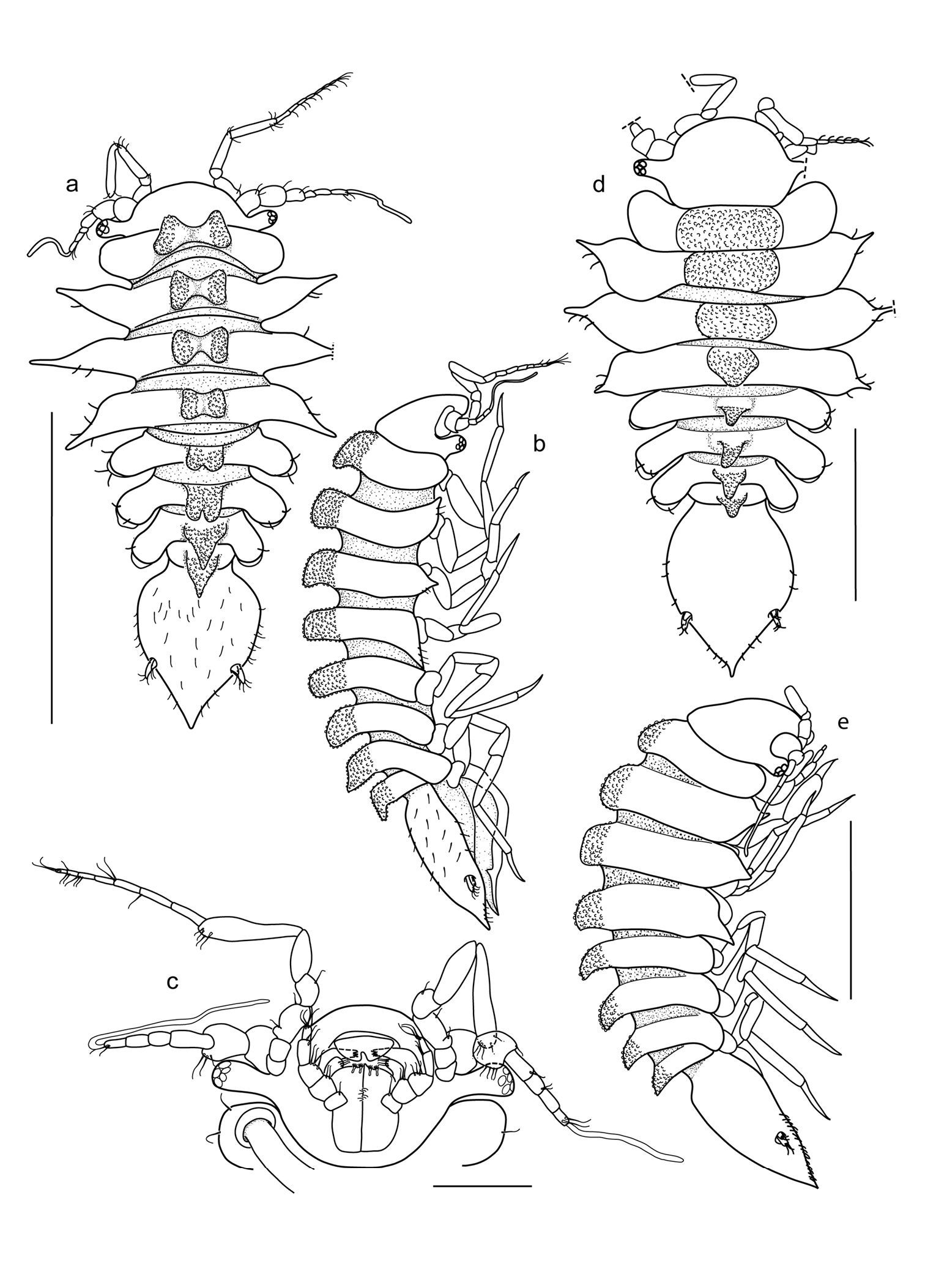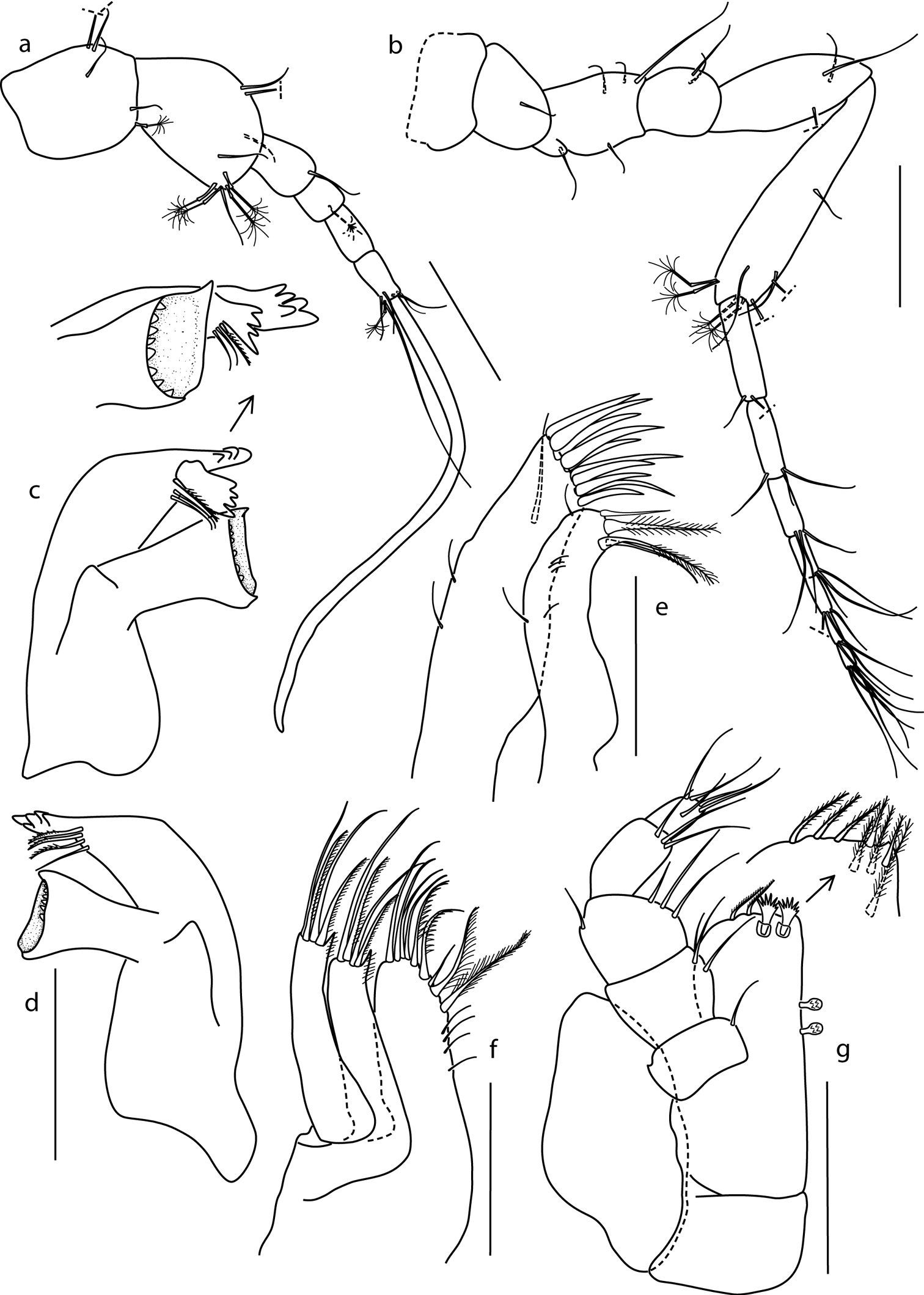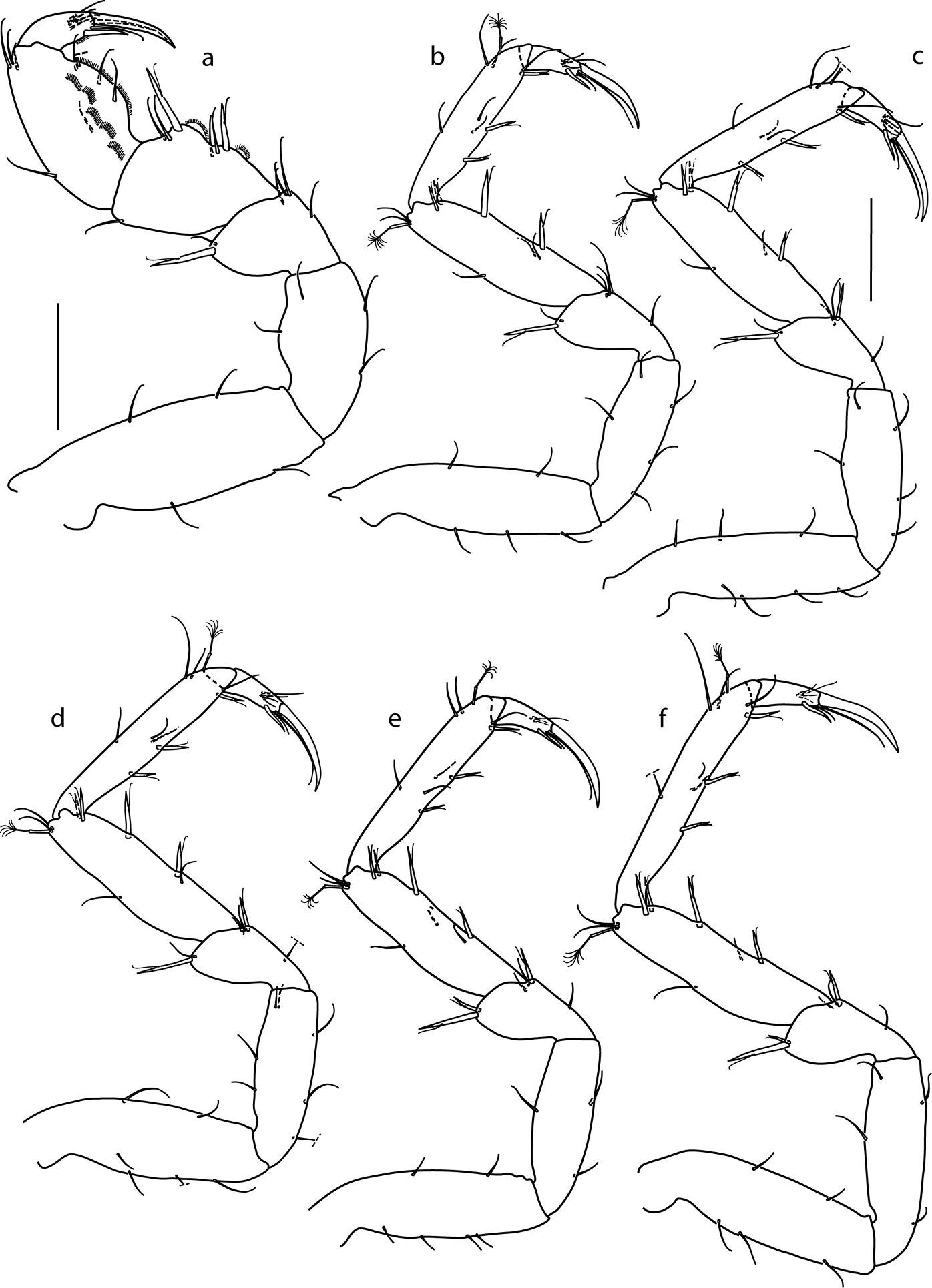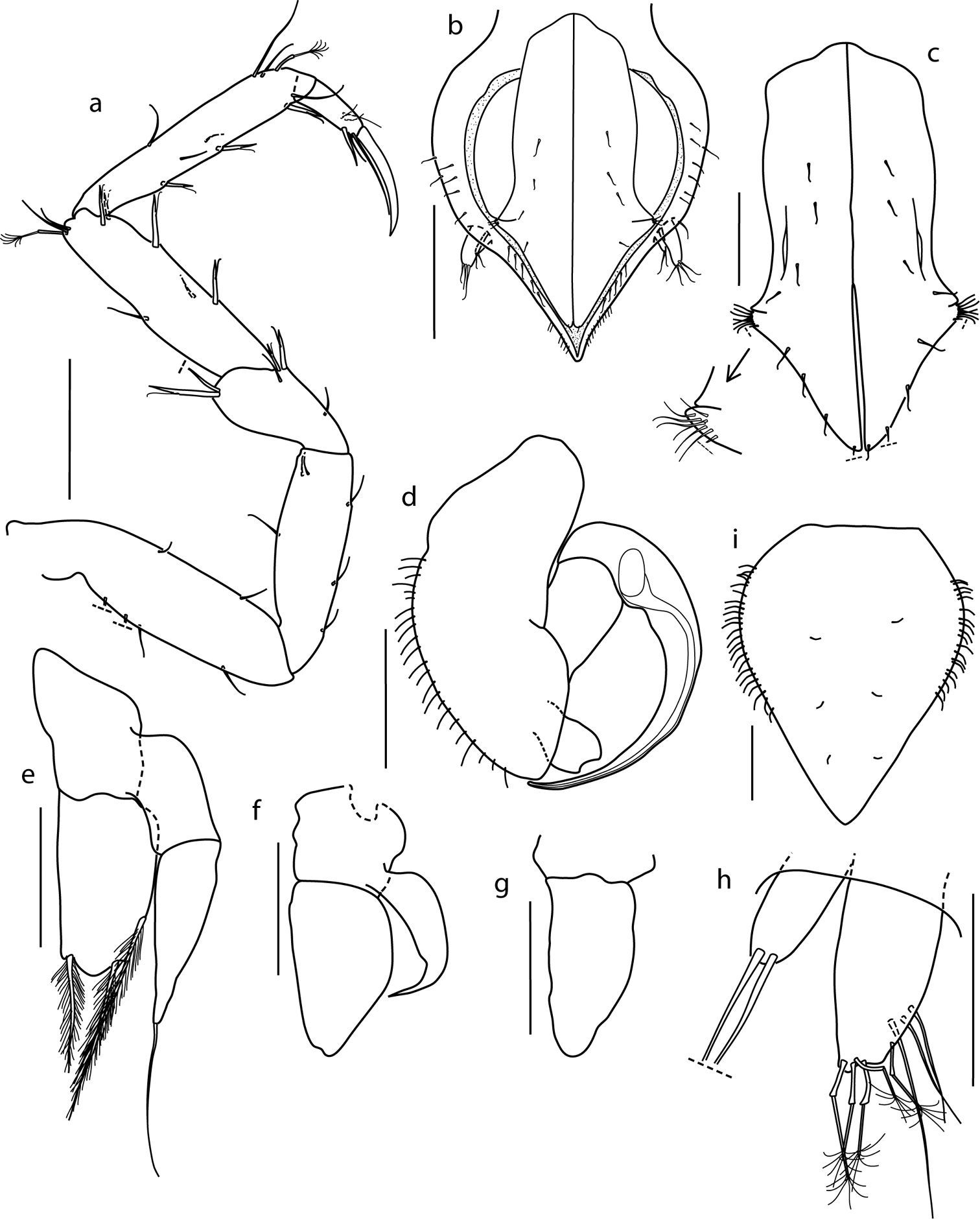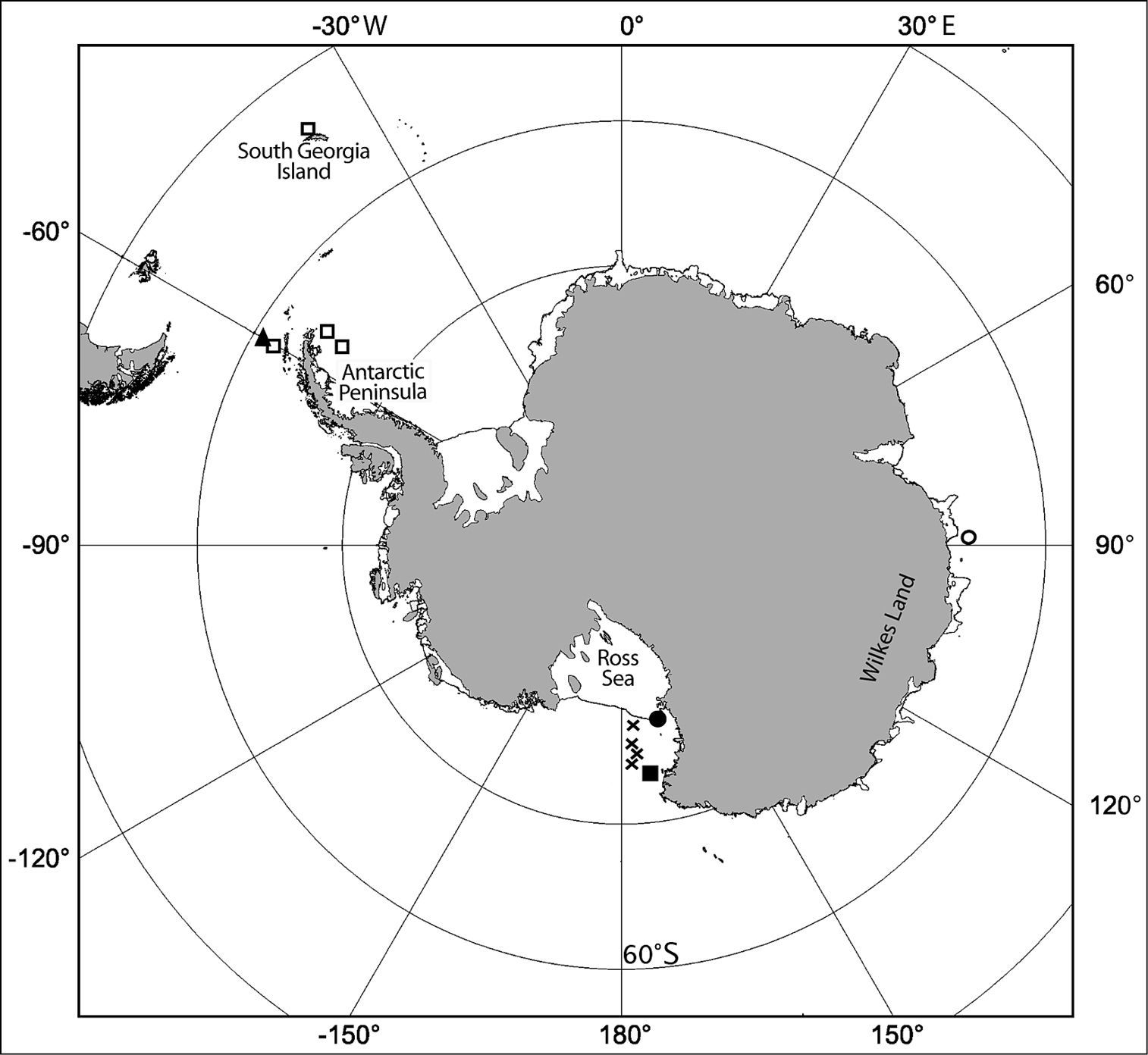(C) 2010 Madhumita Choudhury. This is an open access article distributed under the terms of the Creative Commons Attribution License, which permits unrestricted use, distribution, and reproduction in any medium, provided the original author and source are credited.
For reference, use of the paginated PDF or printed version of this article is recommended.
A new species of Coulmannia, Coulmannia rossensis, is described from the Ross Sea, Antarctica. It is most similar to Coulmannia ramosae Castelló, 2004, but can easily be distinguished from this species bythe males yielding a pair of granulate humps on the dorsum of the pereonites 1–6 and a single granulate hump on the pereonite 7 and the free pleonite. Coulmannia rossensis sp. n. is sexually dimorphic. The dorsal sculpture of the female bodies yield a single granulate hump on all the pereonites and free pleonite. The species of the genus Coulmannia are restricted to the Southern Ocean, and Coulmannia rossensis sp. n. is the fourth species included in it.
Isopoda, Coulmannia, new species, taxonomy, Ross Sea, Southern Ocean
Paramunnidae Vanhöffen, 1914 is a large family of
asellote isopods; at present it includes 42 genera, many of them
recently erected (see
To date species in the genus Coulmannia have been exclusively reported from the Southern Ocean.
Specimens of Coulmannia rossensis sp. n. were collected during the 19th Antarctic expedition to the Ross Sea on board the RV Italica,
in February 2004. Samples were taken along a latitudinal transect
between Cape Adare and Terra Nova Bay with a modified Rauschert dredge (
For the taxonomic description some specimens were stained
with Chlorazole Black E®, and their appendages were dissected and
temporarily mounted in glycerine. Pencil drawings of the whole animal
and dissected appendages were prepared using a Carl Zeiss (Axioskop 2)
compound microscope equipped with a camera lucida. Digital illustrations
were made with a Wacom tablet and the Adobe Illustrator program
following
The length of the head, pereonites, free pleonite, and
pleotelson were all estimated along the mid-dorsal line. The width of
the head was measured between the tips of the eyestalks. Body length as
well as lengths of the articles of the appendages were measured
according to
The material examined of Coulmannia rossensis sp. n. is lodged at the Zoological Museum of Hamburg (ZMH). For comparison purposes, the type material of Coulmannia ramosae Castelló, 2004 (holotype male MZB 2003-1229A and paratype male MZB 2003-1229B) deposited in the Museum of Zoology, Barcelona (MZB) was also examined.
TaxonomyFamily Paramunnidae Vanhöffen, 1914
Coulmannia australis Hodgson, 1910; Coulmannia frigida Hodgson, 1910; Coulmannia ramosae Castelló, 2004 and Coulmannia rossensis sp. n.
| 1 | Lateral margins of all pereonites produced into 2 processes | Coulmannia australis Hodgson, 1910 |
| – | Lateral margins of at least one pereonite produced into a single process | 2 |
| 2 | Lateral margins of pereonite 1 produced into a single process, remaining pereonites produced into 2 processes | Coulmannia frigida Hodgson, 1910 |
| – | Lateral margin of pereonites 2–4 produced into a single process, remaining pereonites rounded | 3 |
| 3 | Male: pereonites 1–6 with a pair of granulate humps mid-dorsally, pereonite 7 and free pleonite with a single granulate hump. Female: all pereonites and free pleonite with a single granulate hump | Coulmannia rossensis sp. n. |
| – | Male: pereonites 1 and 2 with a pair of granulate humps mid-dorsally, remaining pereonites and free pleonite with a single granulate hump. Female: unknown | Coulmannia ramosae Castello, 2004 |
Ross Sea, RV Italica.
Holotype: Adult male 1.7 mm (ZMH 42000-718); station H out 2, 72°17.5'S, 170°29.4'E, 353 m depth, 11 Feb 2004.
Paratypes, same locality as holotype: 5 males (1.3–1.4 mm), 4 brooding females (1.6–1.7 mm), 2 females (1.2, 1.3 mm) and 2 juveniles (0.9, 1 mm); (ZMH 42000-719).
Coulmannia rossensis sp. n. Holotype male (ZMH–42000-718), a dorsal view b lateral view, c head in ventral view. Paratype female (ZMH–42000-719-a) d dorsal view. Paratype female (ZMH–42000-719-b) e lateral view. Scale bars 1 mm (a), 0.2 mm (c), 0.5 mm (d, e); a and b share the same scale.
Additional material: Station H in 3, 72°17.0'S, 170°13.1'E, 316 m depth, 16 Feb 2004: 5 males, 2 brooding females, 1 female and 2 juveniles. Station H in 4, 72°17.1'S, 170°14.0'E, 196 m depth, 16 Feb 2004: 7 males, 3 females and 2 juveniles. Station H in 2, 72°16.9'S, 170°12.2'E, 391 m depth, 10 Feb 2004: 4 males and 1 female. Station SMN, 74°43.2'S, 164°13.1'E, 366 m depth, 20 Feb 2004: 2 males and 2 juveniles. Station H out 1, 72°15.7'S, 170°24.8'E, 458 m depth, 9 Feb 2004: 2 males, 1 female and 2 juveniles. Station H out 4, 72°18.5'S, 170°26.8'E, 235 m depth, 12 Feb 2004: 4 males and 2 females. Station A 4, 71°18.4'S, 170°28.9'E, 230 m depth, 14 Feb 2004: 1 female. Station C 1, 73°24.5'S, 170°23.2'E, 474 m depth, 18 Feb 2004: 1 brooding female. Station C 2, 73°22.7'S, 170°06.9'E, 410 m depth, 18 Feb 2004: 2 males, 3 brooding females, 6 females and 3 juveniles.
Males with dorsal sculpture formed by a pair of granulate humps on pereonites 1–6, and a single granulate hump on pereonite 7 and free pleonite. Females with single granulate hump on all pereonites and free pleonite; hump on pereonite 1 widest and shallowest, following humps gradually becoming narrower and higher towards distal end. Lateral margins of pereonites 1 and 5–7 rounded, those of pereonites 2–4 produced into single process. Coxae rounded, visible dorsally on pereonites 5–7 only.
(body description based on the holotype male, description of appendages based on a paratype male).Body (Fig. 1a, b) total length 1.7 mm; width 0.6 length, widest at pereonite 3. Cephalon width 1.9 length (Fig. 1c), anterior margin broadly rounded. Eyestalks prominent, width 0.6 length, with 5 ommatidia. Pereonites 1–6 with two granulate humps mid-dorsally, pereonite 7 and free pleonite with a single granulate hump each. Lateral margins of pereonites 1 and 5–7 rounded, those of pereonites 2–4 produced into a single process. Coxae rounded, visible in dorsal view on pereonites 5–7 only. Pleotelson and free pleonite together 1.7 as long as last 3 pereonites combined. Pleotelson oval, lateral margins smooth and convex, apex pointed. Uropods inserted at about 2/3 of pleotelson length in posterolateral indentations.
Antennula (Fig. 2a), articles 1–3 longer than wide; first article not extending beyond apex of eyestalk, with 1 penicillate and 4 simple setae; second article largest, with 4 penicillate and 5 simple setae; article 3 shorter than article 2, with 1 simple seta; article 4 shortest, with 1 penicillate seta, article 5 slightly longer than article 6, without setation; article 6 with 5 simple setae, 1 penicillate seta and 1 aesthetasc.
Antenna (Fig. 2b), article 1 broken off during dissection, without setation (see Fig. 1c); article 2 with 1 simple seta; article 3 shorter than article 5, with 5 simple setae; article 4 shortest, with 2 simple setae; article 5 with 3 simple setae; article 6 longest, with 5 penicillate and 5 simple setae; flagellum with 7 articles, each article with numerous simple setae.
Left mandible (Fig. 2c) stout, without palp; incisor process with 5 blunt cusps; spine row with 1 serrate and 2 simple setae; lacina mobilis 4-cusped; molar process cylindrical, transversely truncated, with lower margin of apex toothed. Right mandible (Fig. 2d) as left one, except for: spine row with 3 serrate and 1 simple setae; lacinia mobilis absent.
Maxillula (Fig. 2e), lateral lobe with 10 stout cuspidate setae distally and 1 simple seta near distal margin; medial lobe with 2 simple and 2 setulate setae distally.
Maxilla (Fig. 2f), lateral and medial lobes with 2 simple and 2 pectinate setae, distomedial margin with single acute projection finely setose; inner lobe with 5 simple, 2 pectinate and 2 setulate setae on distomedial margin, 4 simple slender setae on medial margin.
Maxilliped (Fig. 2g), endite reaching half-length of palp article 3, with 2 coupling hooks, distal margin with 4 setulate setae (see detail), ventral surface with 1 setulate and 2 fan setae, dorsal with 3 setulate setae; epipod ovate, width 0.5 length, reaching dorsal margin of palp article 2. Palp, article 1 with 1 tooth on lateral margin, relative lengths of articles 1.0:1.4:1.4:1.7:1.0.
Pereopod I (Fig. 3a) stoutest. Basis longest article, with 4 simple setae. Ischium with 4 simple setae. Merus with 1 robust and 1 simple setae distodorsally, ventral margin with 4 simple setae. Carpus triangular, length 0.88 ischium length, ventral margin with 2 robust and 4 simple setae and 2 cuticular combs, distodorsal margin with 1 simple seta. Propodus oval, ventral and dorsal margins with 4 simple setae each, anterior surface with 1 simple seta and cuticular combs. Dactylus with 4 simple setae near distal margin and 2 simple setae between unguis and ventral claw, unguis slightly longer than dactylus, ventral claw shorter than unguis, approximately 0.5 unguis length.
Pereopods II–VII (Figs 3b–f, 4a) subequal in shape and length. Meri distodorsally with 1 robust seta on pereopods II–IV and 2 robust setae on pereopods V–VII; distoventrally with 1 robust seta on pereopods III–VI and 2 robust setae on pereopod VII. Carpi and propodi with 1 distodorsal penicillate seta each; ventral margin with 4 robust setae and 3 robust setae, respectively. Ungues 1.6–1.9 dactyli length, ventral claws 0.35 ungues length.
Pleopod I (Fig. 4b, c), lateral lobes at level of 2/3 of its length, each lobe with 8 simple setae; ventral surface with 8 simple setae; distal margin with 8 simple setae.
Pleopod II (Fig. 4d), sympod lateral margin rounded and setose; endopod stylet-like, curved to the apex of the sympod, relative lengths endopod: sympod, 1.0:1.3; exopod distally concave, without setae.
Pleopod III (Fig. 4e), endopod width 0.6 length, with 3 plumose setae distally; exopod with 2 articles, distal one with 1 simple seta apically, extending beyond tips of endopod setae.
Pleopod IV (Fig. 4f), endopod width 0.54 length, exopod reaching half length of endopod.
Pleopod V (Fig. 4g) width 0.5 length.
Uropod (Fig. 4h) biramous; exopod 0.4 endopod length, distally with 2 simple setae (broken in the specimen drawn); endopod with 5 penicillate and 3 simple setae.
Coulmannia rossensis sp. n. Paratype male (ZMH–42000-719-c), a antennula b antenna c left mandible with detail of the incisor and molar processes d right mandible e maxillula f maxilla g maxilliped with detail of endite distal end (fan setae were omitted in the detail). Scale bars 0.1 mm (a–d, g), 0.05 mm (e, f); c and d share the same scale.
(Figs 1d, e; 4i). As male in body shape, except for: dorsal sculpture with a single granulate hump on all pereonites and free pleonite; hump on pereonite 1 widest and shallowest, following humps gradually becoming narrower and higher towards distal end. Operculum width 0.74 length, margins finely setose, ventral surface with 6 simple setae. Remaining appendages as those of the male.
Coulmannia rossensis sp. n. Paratype male (ZMH–42000-719-c), a pereopod I b pereopod II c pereopod III d pereopod IV e pereopod V f pereopod VI. Scale bars 0.1 mm; b–f share the same scale.
Coulmannia rossensis sp. n. Paratype male (ZMH–42000-719-c), a pereopod VII b pleotelson in ventral view c pleopod I d pleopod II e pleopod III f pleopod IV g pleopod V h uropod. Paratype female (ZMH–42000-719-a) i operculum. Scale bars 0.1 mm (a, c–g, i), 0.2 mm (b), 0.05 mm (h).
Only known from type locality (Fig. 5).
The species name refers to the type locality, the Ross Sea.
Because of the dorsal ornamentation and the lateral margins of the pereonites Coulmannia rossensis sp. n. is most similar to Coulmannia ramosae Castelló, 2004. The main differences between these two species are (characters found in Coulmannia ramosae in parentheses): two granulate humps on pereonites 1–6, single granulate hump on pereonite 7 and free pleonite (two granulate humps on pereonites 1 and 2, single granulate humps on remaining segments); pleotelson width 0.76 length (width 0.51 length, apex of pleotelson more produced); basis of pereopods with simple setae only (with simple and robust setae); propodi of pereopods II–IV with 3 robust setae (with 4 robust setae).
Geographic distribution of the Coulmannia species. Coulmannia rossensis sp. n. (cross); Coulmannia ramosae Castelló, 2004 (triangle); Coulmannia australis Hodgson, 1910 (square); Coulmannia frigida Hodgson, 1910 (circle). Full square and full circle stand for the type locality of the latter two species.
Character comparison of the species included in Coulmannia Hodgson, 1910. Abbreviations: Prns. = pereonites; PI= first pereopod; RS = robust setae. * This range includes the data from the specimens described by
| Lateral margins of pereonites | Dorsal sculpture of pereonites and free pleonite | Coxae in dorsal view | PI, carpus ventral margin with | Body length (mm) | ||
|---|---|---|---|---|---|---|
| Coulmannia australis Hodgson, 1910 | Prns. 1–7 produced into two processes | One smooth conical hump on each segment (without sexual dimorphism; José Castelló, pers. comm.) | Not visible | 2–5 RS* | 5–9* | |
| Coulmannia frigida Hodgson, 1910 | Prn. 1 produced into a single process, prns. 2–7 produced into two processes | One smooth conical hump on each segment(sexual dimorphism unknown) | Not visible | Unknown | 3.5 | |
| Coulmannia ramosae Castelló, 2004 | Prns. 1 and 5–7 rounded, prns. 2–4 produced into a single process | Two granulate humps on prns. 1–2, single granulate hump on remaining segments(sexual dimorphism unknown) | Visible on prns. 5–7 only | 2 RS | 2.1 | |
| Coulmannia rossensis sp. n. | Prns. 1 and 5–7 rounded, prns. 2–4 produced into a single process | ♂♂: two granulate humps on prns. 1–6, single granulate hump on remaining segments | ♀♀: single granulate hump on all segments, hump on prn. 1 widest and shallowest | Visible on prns. 5–7 only | 2 RS | 0.9–1.7 |
At present, the genus Coulmannia Hodgson, 1910 contains four species, each one with a particular arrangement in the dorsal sculpture of the body and in the lateral margins of the pereonites (see Table 1). It is worth noticing that other genera of Paramunnidae, such as Heterosignum Gamô, 1976; Meridiosignum Just and Wilson, 2007; Holodentata Doti, Choudhury and Brandt, 2009; and Pentaceration Just, 2009 also include species with different dorsal sculptures and/or lateral margins arrays. The pereonites of Coulmannia rossensis sp. n. and Coulmannia ramosae Castelló, 2004 show lateral margins similar to those present in the species of the genus Heterosignum. This genus, however, differs from Coulmannia in having long and slender eyestalks, antenna with an elongate third article, and pleotelson with denticulate margins, anteriorly narrow and cylindrical.
Coulmannia rossensis
sp. n. has a remarkable sexual dimorphism in the arrangement of the
dorsal sculpture. Contrary, no sexual dimorphism was found in Coulmannia australis Hodgson, 1910 (José Castelló, pers. comm.). Regarding Coulmannia frigida Hodgson, 1910, both the original description and that presented by
The four species belonging to Coulmannia were found exclusively in the Southern Ocean, Coulmannia australis being the most widely distributed (Fig. 5). This species was originally described by
Records from the remaining three species of Coulmannia are scarce: Coulmannia frigida was described by
The authors are grateful to the crew of the RV Italica for their help on board. We also would like to thank Dr Peter Rehm for providing and pre-sorting the material of the Italica expedition and Dr Francesc Uribe (Museu Ciències Naturals de Barcelona) for loan of the type material of Coulmannia ramosae. We also thank to Dr Jean Just, Dr José Castelló, Dr George (Buz) Wilson and two anonymous reviewers, whose comments helped to improve the manuscript. The second author is grateful to the DAAD–MECyT for being granted. This study was partially supported by the German Science Foundation (DFG Br 1121/20), the Consejo Nacional de Investigaciones Científicas y Técnicas (CONICET), and the Universidad de Buenos Aires (UBACyT X-190).







